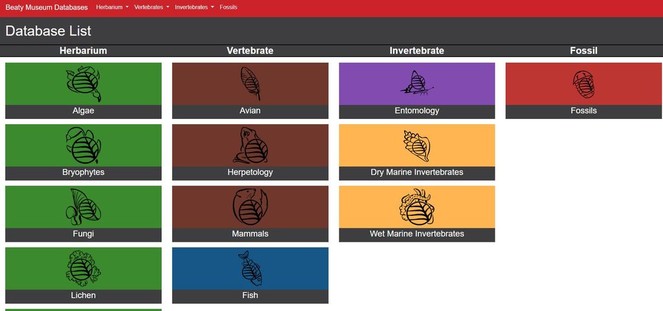|
Biodiversity Information Science and Standards : Conference Abstract
|
|
Corresponding author: David Rowswell (davi144@mail.ubc.ca)
Received: 25 Jun 2019 | Published: 02 Jul 2019
© 2019 David Rowswell, Linda Jennings (Lipsen), Nicolas Bailly
This is an open access article distributed under the terms of the Creative Commons Attribution License (CC BY 4.0), which permits unrestricted use, distribution, and reproduction in any medium, provided the original author and source are credited.
Citation: Rowswell D, Jennings (Lipsen) L, Bailly N (2019) Beaty Biodiversity Museum Collection and Observation Databases: Towards a single search interface. Biodiversity Information Science and Standards 3: e37675. https://doi.org/10.3897/biss.3.37675
|
|
Abstract
The Beaty Biodiversity Museum (BBM), at the University of British Columbia, houses over two million biological research specimens, with nearly 40% of the specimen records digitized into databases, unlocking a wealth of information for research and teaching (Table
Current Searchable Record Count per Database
|
Databases |
Records |
|
Vascular |
181,735 |
|
Algae |
75,259 |
|
Fungi |
32,822 |
|
Bryophytes |
215,967 |
|
Lichen |
56,689 |
|
Avian |
22,117 |
|
Herpetology |
1,895 |
|
Mammal |
20,314 |
|
Entomology |
68,959 |
|
Fish |
34,815 |
|
Dry Marine Invertebrate |
7,064 |
|
Wet Marine Invertebrate |
3,052 |
|
Fossil |
5,515 |
Home page of the interface where one can navigate to any of the searchable collections. (Still in beta, Stable URL is not available yet but it is currently here: https://herbweb.botany.ubc.ca/testSite/).
This was a large collections project with multiple stages of development. Integration of the data was made possible through the efforts of multiple groups to standardize the fields of each database so they conformed to the Darwin Core standard (
Keywords
Beaty Biodiversity Museum, University of British Columbia, Darwin Core, unified search interface, collection research, databases, record search
Presenting author
Nicolas Bailly
Presented at
Biodiversity_Next 2019
References
-
Darwin Core (Kampmeier G, review manager).Biodiversity Information Standards (TDWG). Release date:2009-10-09. URL: http://www.tdwg.org/standards/450
